We all have different hand sizes and learning to play the guitar can be difficult if you have smaller than average hands.
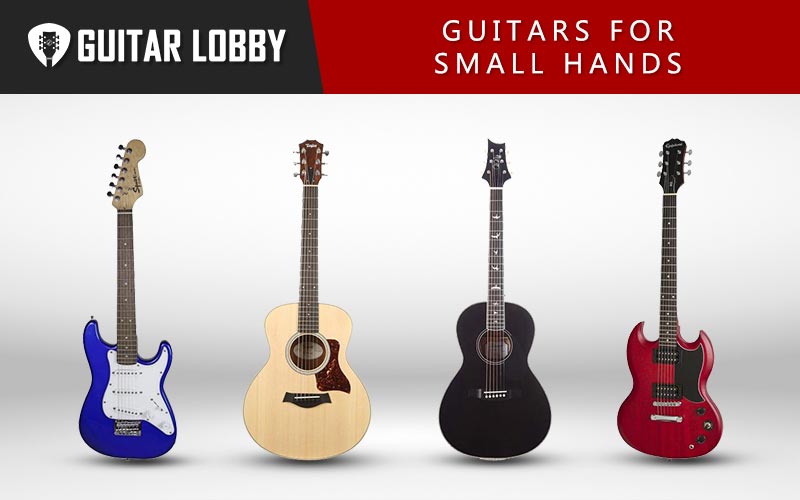
Some entry-level guitarists with small hands fear learning the guitar, but thankfully there are many guitars with specs suited better for these players. When looking for a guitar for smaller hands you’ll want to consider the body size, neck size, neck profile, and other factors that we’ll discuss below. I’ll start this article by jumping into reviews on my favorite electric and acoustic guitars for small hands, but if you want to learn more about guitar sizing, check out our guide on the different ways to measure guitars at the bottom of the page.
| Name of Product | Image of Product | Description | Price Range | Full Review |
|---|---|---|---|---|
| 1. Martin LX1 Little Martin Acoustic Guitar (Best Value Acoustic) | 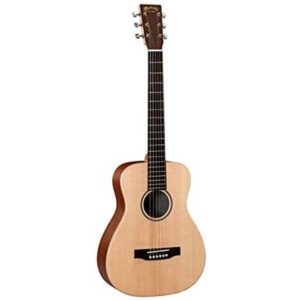 | Body Style: Modified 0-14 Fret Top: Solid Sitka Spruce | $350 | Read Full Review Below |
| 2. Taylor GS Mini (Best Acoustic Under $500) | 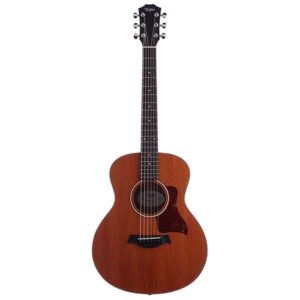 | Body Style: Taylor Grand Symphony Mini Top: Solid Mahogany | $500 | Read Full Review Below |
| 3. PRS SE Parlor P20 Acoustic Guitar (Editor's Choice Acoustic) | 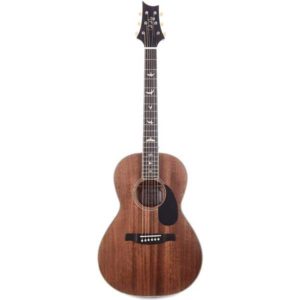 | Body Style: Parlor Top: Mahogany | $500 | Read Full Review Below |
| 4. Yamaha APXT2 ¾ Size Thin-line Cutaway (Budget Pick Acoustic) | 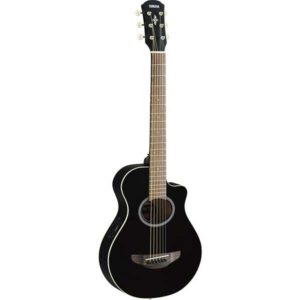 | Body Style: Single Cutaway body Top: Spruce | $200 | Read Full Review Below |
| 5. Martin OM-28 (Best Overall Acoustic) | 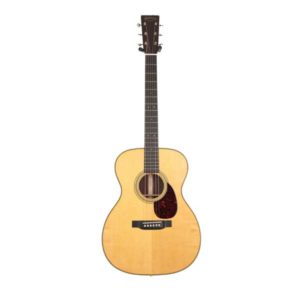 | Body Style: OOO 14 Fret Top: Sitka Spruce | $3100 | Read Full Review Below |
| 6. Epiphone SG Special VE (Best Value Electric) | 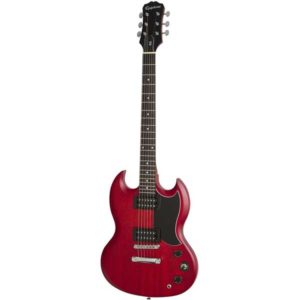 | Body Style: Double Cutaway Top: Solid wood | $280 | Read Full Review Below |
| 7. Ibanez Mikro GRGM21M (Budget Pick Electric) | 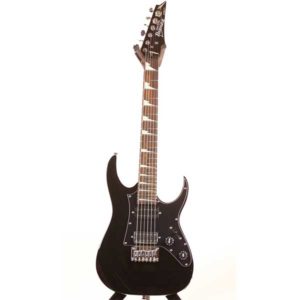 | Body Style: Double Cutaway Top: Polar | $150 | Read Full Review Below |
| 8. Fender Vintera ‘60s Mustang (Best Electric Under $1000) | 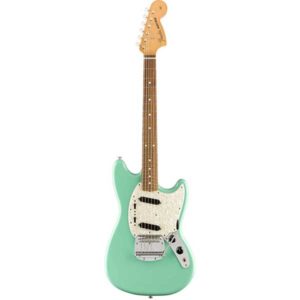 | Body Style: Double Cutaway Offset Top: Solid Wood | $900 | Read Full Review Below |
| 9. Gibson SG Standard ‘61 (Editor's Choice Electric) | 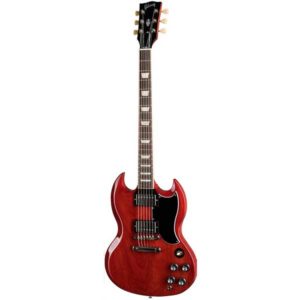 | Body Style: Double Cutaway Top: Mahogany | $1800 | Read Full Review Below |
| 10. Ernie Ball Music Man John Petrucci Majesty (Best Overall Electric) | 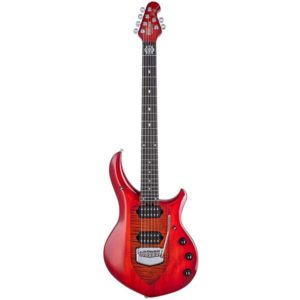 | Body Style: Double Cutaway Top: Mahogany | $3500 | Read Full Review Below |
| 11. Taylor Baby Mahogany BT2e Acoustic-Electric Guitar | 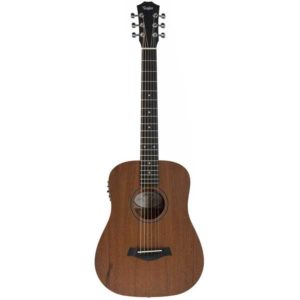 | Body Style: Dreadnaught ¾ size Top: Solid Mahogany | $470 | Read Full Review Below |
| 12. Yamaha FS800 Concert Acoustic Guitar | 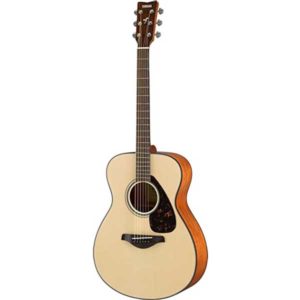 | Body Style: Concert/O Top: Soli Spruce | $200 | Read Full Review Below |
| 13. Martin OOOJr-10 Acoustic Guitar | 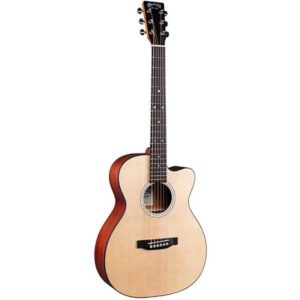 | Body Style: Dreadnought Junior Top: Sitka Spruce | $500 | Read Full Review Below |
| 14. Squier Classic Vibe ‘70s Jaguar | 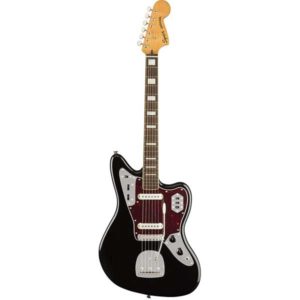 | Body Style: Offset Top: Poplar | $450 | Read Full Review Below |
| 15. Squier Mini Strat Electric Guitar | 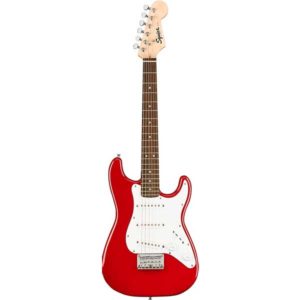 | Body Style: Double Cutaway Top: Laminated Hardwood | $180 | Read Full Review Below |
| 16. Epiphone Les Paul Standard ‘60s | 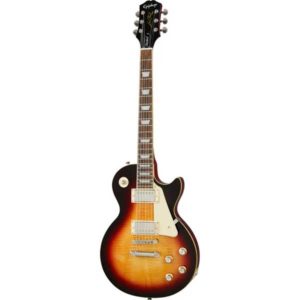 | Body Style: Single Cutaway Top: AA Flame Maple Cap | $600 | Read Full Review Below |
| 17. Jackson Dinky Arch Top JS32 DKAM | 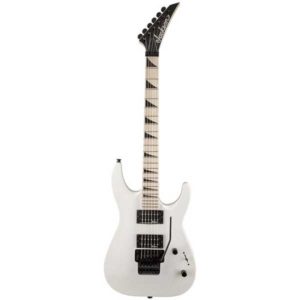 | Body Style: Dinky Top: Poplar | $230 | Read Full Review Below |
Here Are the Best Guitars for Small Hands (Acoustic and Electric)
1. Martin LX1 Little Martin Acoustic Guitar (Best Value Acoustic)
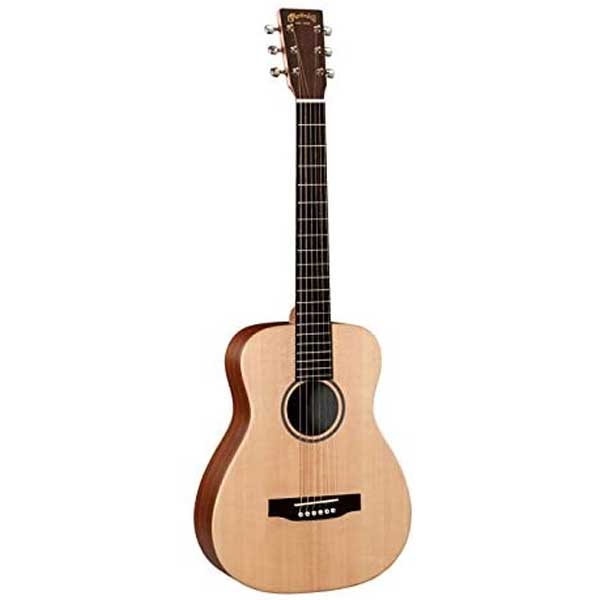
| Estimated Price | $350 |
| Body Style | Modified 0-14 Fret |
| Top | Solid Sitka Spruce |
| Back and Sides | Mahogany Pattern HPL Textured Finish |
| Neck | Rust Stratabond |
| Finish | Hand Rubbed |
| Body Bracing | Modified X Series X, Crowned Cross Brace |
| Fret Count | 20 |
| Country of Origin | Mexico |
My Review: The Martin LX1 Little Martin is a great guitar to start off this list. Created as a travel guitar, Martin LX1 is an amazing option for guitar players with small hands. Produced at the Martin facility in Mexico, it’s a rare chance to experience the one and only Martin guitar sound for less than $400 bucks.
The overall length of the guitar is only 34 inches, which is at least 4 inches shorter than regular sized guitars. It’s super comfortable in your hands, and you can carry it anywhere like you would carry a backpack. The scale length is only 23’’, and so the length between frets will be a lot shorter and will be easier to grab than your regular guitars.
Little Martin has the classic Martin non-cutaway body and has a solid Sitka Spruce top. The back and sides of the body are made up of laminated Mahogany. On the neck, the guitar has rust birch laminate, and this provides an even more comfortable playing feel. On top of that, it also has other high-quality Martin parts, like Richlite fretboard and Martin sealed chrome tuners. The guitar has up to 20 frets, and you can reach up to 14 frets without the guitar body getting in the way. Now that’s a surprising amount of frets for such a tiny guitar, and you can still play your favorite song that uses higher frets, just like you would with a regular size guitar.
The LX1 version is only purely acoustic, and you would need a microphone for performing live or recording with this guitar. If you want a guitar that you can plug straight into an amp or a PA system, The Martin LX1E version provides Fishman electronics where you can just plug a guitar cable in.
Now you might be curious how does this little guitar sound like? I mean, it has the Martin brand name with it, so it must sound great. If you’re curious about the sound, just listen to Ed Sheeran performing live! He absolutely loves the Little Martin guitars, and he even fills up the Wembley Stadium with just this little guitar (LX1E version) and his looper. Even with its small size, Martin LX1 produces a satisfying well-balanced, warm, beautiful sound. Obviously, the sound wouldn’t be as large as a full-size Martin guitar, but it will still provide big enough sound for practicing, recording, and even performing while being extremely comfortable for anyone to play. They also come with a high-quality padded gig bag, and so if you have small hands or are looking for a travel companion, look no further than the Martin LX1! I’d say that this is the best acoustic guitar for small hands that’s under $400.
2. Taylor GS Mini (Best Acoustic Under $500)
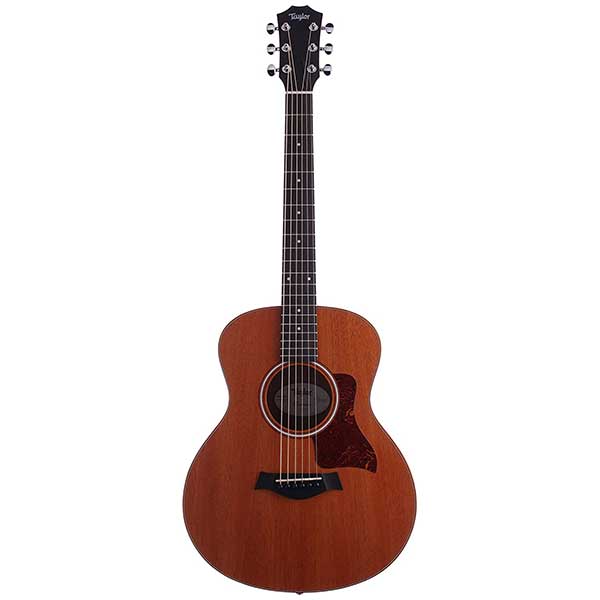
| Estimated Price | $500 |
| Body Style | Taylor Grand Symphony Mini |
| Top | Solid Mahogany |
| Back and Sides | Layered Sapele |
| Neck | Sapele |
| Finish | Matte 2.0 |
| Body Bracing | GS Mini With Relief Rout |
| Fret Count | 20 |
| Country of Origin | Mexico |
My Review: Now here is a guitar, which is one of the biggest competitors to the Little Martin, the Taylor GS Mini. Taylor and Martin have been the two biggest companies in the acoustic guitar market for quite a while, and both companies are known to produce the highest quality commercial guitars in the market. It’s almost hard to go wrong with both of these companies, and it seems like they’re battling it out again for the best travel/small-sized guitar in the world.
While the Little Martin has the general shape of something between Parlor and Triple O style shape, Taylor GS Mini has the same no cutaway body shape, but clearly has much rounder body shape. GS Mini definitely has a larger size than the Little Martin – 23.5’’ scale length, and 36.6’’ overall length. But the number one feedback from the guitar players is that the GS Mini is extremely comfortable to play and that it basically feels like a full-size guitar when you’re playing it. At the same time, the shorter scale length and the curves on the guitar shape allow the guitar to fit perfectly to your body and make it easier for your fingers to fit onto the fretboard. So GS Mini is perfect for children and adults with small hands, great for taking it on-the-go, and just an overall super comfortable guitar to have around.
Taylor GS Mini is also produced in Mexico and the back and the sides are made up of Layered Sapele, and the top is made up of Tropical Mahogany. The neck profile is not the common “C” shape, and it’s a soft “V” shaped neck.
The sound is just as surprising as the comfort, and despite the smaller size, Taylor GS Mini has a big, full sound like a full-size acoustic guitar. It almost has the recognizable Taylor sound – a warm, clear tone that is full of midrange but also has shimmering highs and tight low end. This makes the GS Mini also a great recording guitar, and you can get some pretty high-quality acoustic guitar recordings with this little beast. Without seeing the guitar, it’ll be pretty hard to guess that you’re listening to a “travel guitar”.
3. PRS SE Parlor P20 Acoustic Guitar (Editor’s Choice Acoustic)
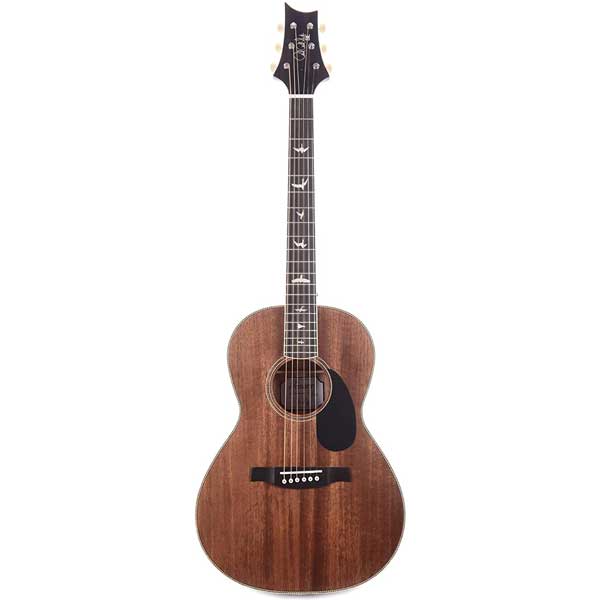
| Estimated Price | $500 |
| Body Style | Parlor |
| Top | Mahogany |
| Back and Sides | Mahogany |
| Neck | Mahogany |
| Finish | Hand Rubbed |
| Body Bracing | X-Brace |
| Fret Count | 20 |
| Country of Origin | South Korea |
My Review: Let’s do a quick history lesson on guitars. In the 19th century, the most popular guitar shape was something called parlor guitar. It looks like a Spanish classical guitar from a long time ago, and so it’s safe to say they are a mix between Spanish classical guitars and modern day big acoustic guitars. They were first designed for women as a guitar suited for women with smaller frames than men. But because of its comfort, men and women alike all loved playing the parlor guitars and they were played by the early blues musicians like Robert Johnson. Fast forward to today, parlor guitars are back in fashion, and with today’s technology, some amazing parlor guitars are available at an affordable price.
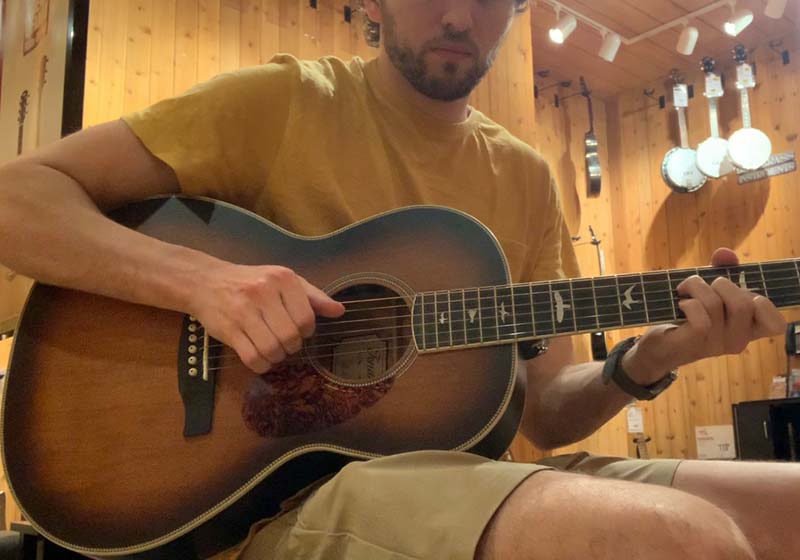
One of the companies that brought back the old classic shape is PRS (Paul Reed Smith). You probably have heard of them, probably from their top-of-the-line solid body or semi-hollow body guitars. And now they released some amazing parlor shape acoustic guitars. The PRS SE Parlor P20 is a vintage-inspired guitar and also added in modern features that have upgraded the parlor guitar.
I was stunned by this guitars looks. It comes in three satin finishes: black, charcoal, and vintage charcoal. All three have a very vintage but luxurious look, and PRS added features like herringbone creme binding and rosette and ebony fretboard with PRS Birds inlay to upgrade the looks. The headstock and tuning machines are also gorgeous – finished with vintage style butterbean buttons on the tuning machines and the classic PRS headstock.
The guitar is all mahogany from the top, sides, back, and neck of the guitar. PRS also used a new technology on this guitar called X-brace/classical hybrid bracing, and this technique combined with all-mahogany gives this guitar a much larger and resonant sound. The tone is warm and bold, and there is a lot of depth to the sound. Even to professional guitarist’s standards, the quality is enough for recording, touring, and gigging with the guitar. Now, this version doesn’t have any pickups, so you would need to mike the guitar for recording and performing purposes. If you want a pickup attached, you can invest $80 more to buy the P20E version, which comes with Fishman GT1 Electronics.
The price of the guitar at this quality is jaw-dropping, especially considering many popular PRS models are well over $2000. The scale length is just slightly shorter than an average full size guitar – at 24.72’’. But because of the slim body size, it would feel a lot more comfortable on your body than a regular acoustic guitar. Overall, an amazing quality guitar with a killer looks at a bargain price. It’s a great choice for anyone looking for a small guitar! In my opinion, this is the best acoustic guitar for small hands that is still within the price range of the average consumer.
Related Article: Our Favorite American Made Guitars
4. Yamaha APXT2 ¾ Size Thin-line Cutaway (Budget Pick Acoustic)
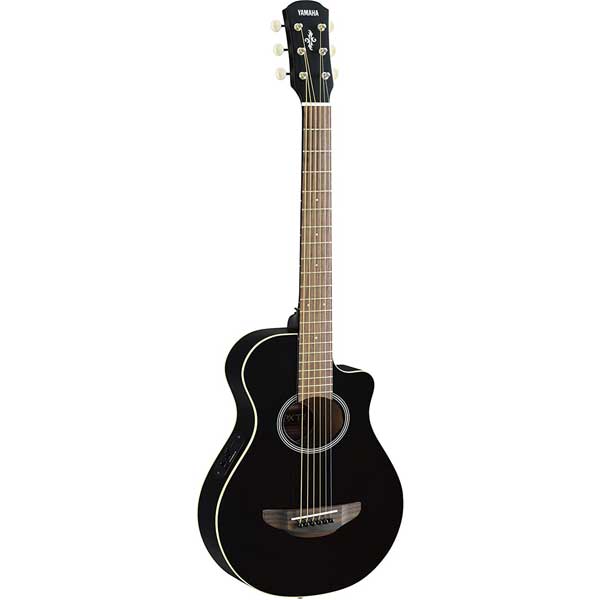
| Estimated Price | $200 |
| Body Style | Single Cutaway body |
| Top | Spruce |
| Back and Sides | Meranti |
| Neck | Nato |
| Finish | Gloss |
| Body Bracing | APX Thinline |
| Fret Count | 21 |
| Country of Origin | China |
My Review: Here is a much more affordable guitar, offered with guitar pickups included. The electronics will allow you to plug in straight into an amp or a PA system, and perform anywhere. It’s a comfortable instrument to play with a decent sound under $200, so it’s a great deal for beginners and young adults with small hands!
Yamaha APXT2 is based on one of the most popular acoustic guitar models – the Yamaha APX500II. The design and many of the specs are very similar to the APX500. Like the classic model, it has a single-cutaway body shape in black color. It comes with a laminated spruce top and the familiar oval sound soundhole. The back and sides of the guitar are made of a wood called Meranti, which is a cheaper version of mahogany.
The main difference comes with the size. APXT2 is ¾ guitar, and has a scale length of 22.835’’. That’s more than 2 inches shorter than a regular size guitar, and that makes a noticeable difference in the length between the frets. The single-cutaway shape will also help you reach up to the higher frets way easier than the non-cutaway guitar body. It has up to 21
frets, which will be more than enough frets for playing all the music you love. The bridge is made of rosewood, and the nut and saddle are unfortunately made of plastic due to affordable pricing.
Another advantage is the simple but reliable electronics on this guitar. APXT2 has an ART based preamp and System 68 Contact pickup that you can plug straight into an amp or a PA system. It’s a relatively simple system with just master volume and tone control and a tuner. More experienced players that play acoustic guitars might be used to having a set of EQ controls, but for under $200, it’s good for playing it on stage or rehearsing with the guitar. If you feel the need to alter the EQ, you can always adjust your EQ on your amp, PA system, or a separate pedal.
Most that have played this instrument recognize instantly that this doesn’t sound like a guitar under $200. Yamaha APXT2 has a full sound with plenty of mids and bass, and it also responds very well to the effects like reverb delay, so the tonal possibilities are endless with this guitar. APXT2 also has a very thin neck compared to regular acoustic guitar, and so it’ll be easier for beginners to grab big chords like barre chords. If you’re someone that is just starting on the guitar, and if you have small hands, the Yamaha APXT2 comes at an extremely affordable price with all the features that you would need to practice, perform and record with the guitar. I’d say that this is the best guitar for small hands that’s under $200.
5. Martin OM-28 (Best Overall Acoustic)
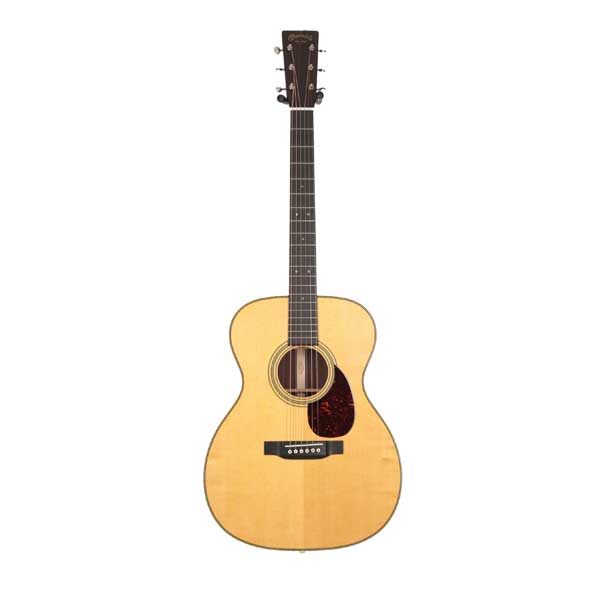
| Estimated Price | $3100 |
| Body Style | OOO 14 Fret |
| Top | Sitka Spruce |
| Back and Sides | East Indian Rosewood |
| Neck | Solid mahogany |
| Finish | Gloss Nitrocellulose |
| Body Bracing | 5/26’’ Scalloped X Bracing |
| Fret Count | 20 |
| Country of Origin | USA |
My Review: Here we have one of the very best acoustic guitars money can buy, and these are comfortable for smaller hands as well. The Martin OM(Orchestra Model) series, specifically the OM-28 has been the gold standard of acoustic guitars along with Martin’s Dreadnaught series. Its history goes back over 90 years and at the time, the OM series was first designed at the request of dance band leader Perry Bechtel. A group of banjo players such as Perry Bechtel needed an instrument with more amplification, and the world’s first 14 fret steel string flat top was born. The OM-28 had a signature 14 fret designed which was revolutionary, and you could reach all the way up to the 14th fret without the interference of the body getting in the way.
Since then, the OM series and the D series of Martin were equally loved by the public, and guitarists like Eric Clapton, Bob Dylan to Tommy Emmanuel, and John Mayer all loved the OM series. A legendary guitar like the OM-28 is something that would last a lifetime or more, and if preserved well, the guitar will age into a more beautiful sound. Orchestra Models and Dreadnaughts each clearly have their own specific sound and characteristics. OM models have a much smaller body than Dreadnaughts, and generally have more midrange, and are warmer sounding generally. Dreadnaughts have a larger body, and because of that, they have much more bass and a little more fuller sound, and they are perfect for strumming chords.
First off, the newest OM-28 has a Sitka Spruce top, and they can source the previous East Indian Rosewood for the back and sides of the guitar, and the fretboard and the bridge are made of ebony. With the newest version of the OM-28, Martin focused on going back to its roots but also adding some new technology.
Things they brought back from their old models are the old style Martin headstock script and historically accurate abalone diamonds inlay. These two things make the guitar look vintage and add a whole another layer of luxury to the guitar. Other new features on the guitar are
the scalloped X-bracing, open-gear tuners, and bold herringbone binding. The scalloped x-bracing improves resonance and adds more bass to the overall tone, and the bold herringbone binding just adds another classy sexiness to the guitar. The build quality is the highest quality as you might expect from the price and the quality of the guitar construction, you can be sure that this instrument will last an extremely long time in prime condition.
Now when it comes to playing comfort, Martin OM-28 has some of the most comfortable body shapes among the Martin guitars. If you’re someone with a smaller body frame and small hands, it would be pretty difficult to wrap your body around a full size Dreadnought type guitar. The rounder and smaller frame of the OM-28 allow you to easily wrap your arms around the guitar. The neck profile of this new OM-28 is something called a modified low oval, and it’s a high performance taper neck. This basically means the neck is relatively thin and has a nice low oval shape, allowing the players to grab the guitar neck with ease. So even though this guitar has a full-size scale length, it’ll be very comfortable for all hand sizes to play.
You might be wondering about the tone of this gorgeous and expensive guitar, and the tone is as good as, if not better than the excellent guitar construction. The overall tone can be described as perfectly balanced, and the characteristic of the guitar is that it has a very pronounced midrange. Orchestra Models are known to have less bass than some of its bigger siblings in Martin, but the scalloped x-bracing in this new design provides more bass than the past versions. The strong mids make this perfect for fingerstyle and gentle strumming, and OM-28s are known to be great acoustic guitars for recording. Just set up a condenser microphone in front of this beauty and record some fingerstyle playing, and you’ll be amazed at the depth and the lushness of this guitar. The bottom line is that this is one of the best guitars for small hands out there, period. This is a buy once, cry once type of purchase.
Popular Related Article: Types of Acoustic Guitars Explained
6. Epiphone SG Special VE (Best Value Electric)
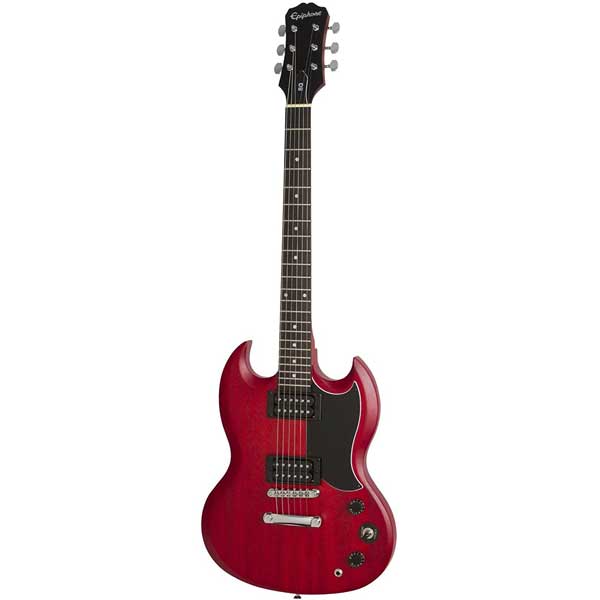
| Estimated Price | $280 |
| Body Style | Double Cutaway |
| Top | Solid wood |
| Back and Sides | Poplar with mahogany veneer |
| Neck | Mahogany |
| Finish | Satin |
| Body Bracing | – |
| Fret Count | 22 |
| Country of Origin | China |
My Review: SG guitars were around since the early ‘60s from Gibson. SG stands for Solid Guitar, and they are characterized by the two horns on the double-cutaway body. It is significantly lighter than the Les Pauls and has a much smaller and thinner body. They are the perfect electric guitar for smaller people, and even the legendary Derek Trucks got started with the Gibson SGs because it was the only electric guitar that he could play when he was a small child. And despite their small size, SGs can pack some mean punch and you can really deliver a big rock sound from this gorgeous instrument.
For the first guitar on the electric guitar section, here is a small guitar that is extremely hard to beat for its build quality vs price – Epiphone SG Special VE. Epiphone is a company within Gibson (bought by Gibson in 1957) and Epiphone is known to produce some high-quality guitars that are very affordable at the same time. The USA-made Gibson guitars are way over the budget for many guitar players, and with Epiphone, you can experience a similar quality Gibson instrument with a much cheaper price point.
Epiphone SG Special VE has a Poplar body with a mahogany veneer top. The neck is made of Okoume wood, and they made sure to add the signature D shape profile with a slim 60s taper. The D slim 60s taper is the most popular neck profile for Gibson and Epiphone and with this thin neck, even young adults and kids can grab those full barre chords and bend the strings with ease. The fretboard has up to 22 frets, which is enough for playing most songs, and it’s made of rosewood with Pearloid dot inlays on them. Epiphone also made sure to include the classic Gibson features like chrome die-cast tuners, Locktone tune-o-matic bridge with stop bar tailpiece. And just like the OG Gibson version, the SG Special VE has the master volume, master tone, and a three-way pickup switch.
Now let’s talk about one of the most crucial parts of an electric guitar: pickups. To make this guitar affordable, Epiphone used ceramic pickups instead of Alnico V magnets. The bridge has Epiphone’s ceramic 700T, and the neck has Epiphone ceramic 650T. You probably won’t get the same detailed clean sound with ceramic pickups, but you can be sure that you’ll be able to get a hot rock guitar sound with these. The tone from these pickups are powerful and loud, and they are a perfect pair for rock, blues, and even metal. They have a good sustain when you play, and have a full midrange for punching through a wall of sound in an ensemble or a band. Most importantly, you have to remember that all of the things I talked about above comes at a price of less than $200. For the inspiring rock stars with small hands, worry no more! The Epiphone SG Special VE is ready for you to shred on it!
7. Ibanez Mikro GRGM21M (Budget Pick Electric)
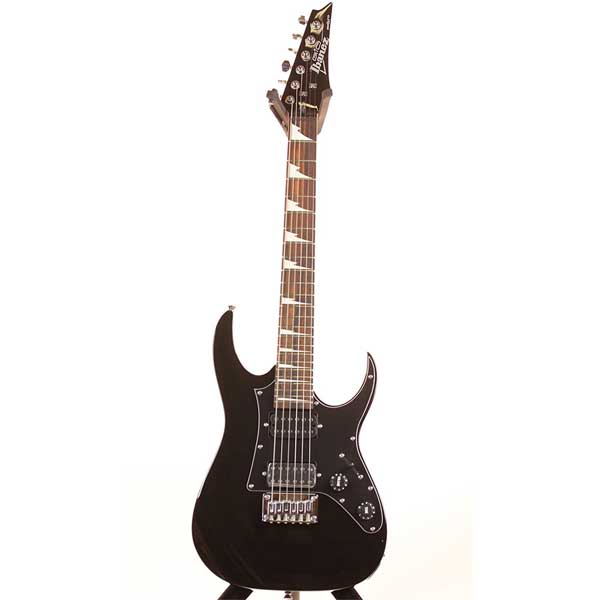
| Estimated Price | $150 |
| Body Style | Double Cutaway |
| Top | Poplar |
| Back and Sides | Poplar |
| Neck | Maple |
| Finish | Gloss |
| Body Bracing | – |
| Fret Count | 22 |
| Country of Origin | China |
My Review: Right up there with Gibson and Fender, Ibanez has also been producing some of the best electric guitars, and their guitars have always been at the forefront of technological advancement for electric guitars. Their guitars are made by guitarists like Steve Vai, Joe Satriani, and Paul Gilbert, and they’re known for producing the top shredding guitars. Ibanez also does a great job of producing guitars of all price ranges including this Ibanez Mikro GRGM21M (hard name to learn).
Right off the bat, you will notice that this guitar is smaller, and it has a ¾ sized body. It has an unmistakable RG body, and they are available in very unique finishes and colors such as Jewel Blue and Metallic Purple for those of you who love guitars with unique finishes! The scale length is 22.75’’ and it’s definitely a small guitar that’ll fit even a child’s hand. Another interesting thing is that the scale length is only 22.75 inches, it has 24 frets! And you have unrestricted access to the 18th fret, which allows you to shred on those higher registers easier than any other guitar on this list.
The value of this guitar is crazy. Coming at only $150, the GRGM21M has two humbuckers – a pair of Powersound humbuckers. Compared to the Mini Strat, the humbuckers give you a darker and more powerful sound. If you’re into metal or hard rock, you can shred on this thing with ease (with some practice of course). The tone can be described as heavy and harsh, making it the perfect match with some hardcore distortion. It has a tight midrange and less low end than the high end Ibanez guitars.
Other than that, some other features are a maple fretboard with black dot inlay and plastic nut. It also has a noticeable thin guitar neck, so you can move up from the 1st fret to the 24th super fast. The thin neck also allows you to bend and do more expressive vibratos. At just $150, get this guitar for shredding on some Metallica or maybe even some Slipknot
Popular Related Article: 40 Easy Guitar Solos for Beginners
8. Fender Vintera ‘60s Mustang (Best Electric Under $1000)
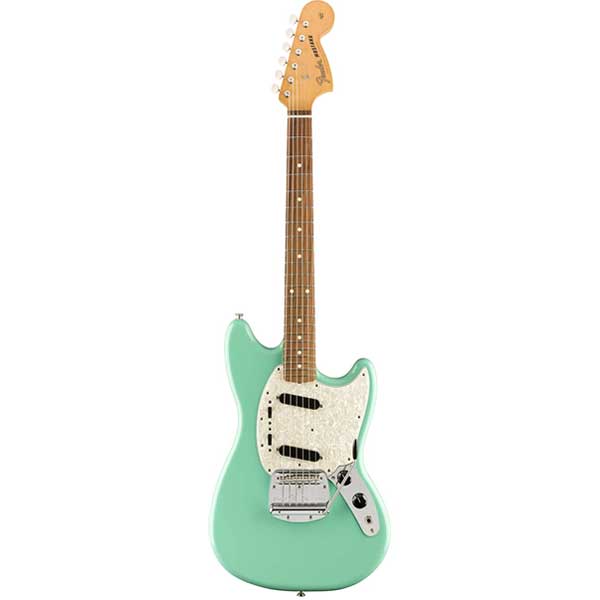
| Estimated Price | $900 |
| Body Style | Double Cutaway Offset |
| Top | Solid Wood |
| Back and Sides | Alder |
| Neck | Maple |
| Finish | Gloss |
| Body Bracing | – |
| Fret Count | 22 |
| Country of Origin | USA |
My Review: We all think of Stratocasters and Telecasters when talking about Fender, but Fender Mustangs have also been around since the ‘60s. Mustangs had a little different designing process because they were initially designed based on Fender’s student models – Musicmaster and Duo-Sonic. Mustangs have an iconic offset body with almost Fender electric bass-like body, and they became a pretty iconic instrument after guitarists like Kurt Cobain or the band Talking Heads used them often. Still, even to this day, Mustangs remain a more unknown instrument compared to Strats or Teles. But if you’re a fan of alternative rock, punk, or pop, you might just love this uniquely shaped instrument, because it’s a great instrument for small hands as well.
Fender introduced the Vintera ‘60s Mustang with very refreshing colors and in this particular model, we’re looking at the Lake Placid Blue. They have an Alder body with a maple neck and have a Pau Ferro fretboard with 22 frets. Other than the signature offset body, the Mustangs also feature unique slider switching options. With this feature, you get four very unique pickup options – neck pickup only, bridge pickup only, both pickups in phase, or both pickups out of phase. There’s plenty of headroom to mess around with the tones, and the Mustangs are perfectly matched with some chorus or phaser effects.
Another great thing about this guitar is the scale length. Vintera ‘60s Mustang has a scale length of 24 inches, which is over an inch shorter than Fender Strats and Teles. So you can grab your favorite jazz chords or power chords or barre chords with ease, and the ‘60s C shaped neck allows you to grab the chords easily. On top of that, Vintera ‘60s Mustang has a very attractive Pearloid pickguard and vintage-style tremolo bridge to add to the classy look, and you can be assured that you’ll be able to bend down on those tremolo bars all day long without changing the tuning.
Now let’s talk about the sound of this instrument. Just like the refreshing color options for this guitar, the Vintera ‘60s Mustang has rather refreshing and sparkling clean sounds. The clean tones are balanced and very playable without any additional effects, but some delay or reverb or even chorus might elevate the sound a little. The Mustang also works well with some distortion or overdrive, and it might be a little hard to get the best shredding lead sound (although you could), you can get the best alternative rock or punk rock tones from this guitar. So to those of you that are into indie rock, alt-rock, punk rock, or indie music in general, the Fender Vintera ‘60s Mustang is for you! Overall, I’d say that this is the best electric guitar for small hands that’s under $1000.
9. Gibson SG Standard ‘61 (Editor’s Choice Electric)
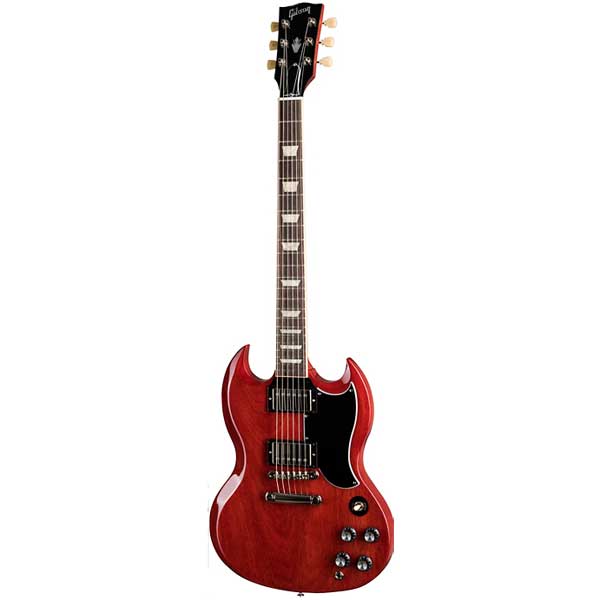
| Estimated Price | $1800 |
| Body Style | Double Cutaway |
| Top | Mahogany |
| Back and Sides | Mahogany |
| Neck | Mahogany |
| Finish | Gloss |
| Body Bracing | – |
| Fret Count | 22 |
| Country of Origin | USA |
My Review: Whether it’s from the hands of Derek Trucks or Angus Young, you probably have seen this guitar a whole lot. Launched in 1961, the Gibson SG model is short for “solid guitar”, and it was one of the first guitars that were released after Gibson ended the contract with Les Paul. They were descendants of the Gibson Les Paul, created after Gibson was experimenting with smaller versions of the Les Paul guitar – Les Paul Junior, TV, and Special models. They soon made a thinner, double-cutaway version of those guitars, and a few years later, that guitar became the Gibson SG. It was only after 1963 where that model officially became the Gibson SG, after Les Paul’s endorsement contract ended in 1962 with Gibson. This was a way for Gibson to respond to their competitors Fender and Gretsch, and especially Fender was launching instant hits after hits with their new models. But for Gibson, it took them years to really master their SG model, and one of the final pieces was the ABR-1 (tune-o-matic bridge) and PAF (pickups). After the 1960s, and 1970s, the Gibson SG became their most popular model, and the SG soon became an iconic solid-body guitar of the 20th century.
The shocking thing about a good SG is how much sound it produces from such a small body. When on full blast, it resonates super well and creates such a deep overdrive and distortion tone. SG has its own personality to it, you’ll know what I mean if you listen to Angus Young’s playing. Gibson’s mahogany construction adds a touch of brightness and provides plenty of sustain. Another shocking thing about Gibson is its tonal variety and genre diversity. From Sister Rosetta Tharpe to Spinal Tap Nigel Tufnel to Derek Trucks, this thing nails so many different styles. Now that we’re almost coming to the end of this review, let’s take a look at some electric guitars that are the highest of the highest quality. We introduced a cheap Epiphone version of the Gibson SG, but here is the original SG made by the Gibson.
Like the guitars above, the Gibson SG Standard ‘61 is an effort to go back to the original model, and use what worked best but also make minor new modifications. They are available in three different versions, with Maestro Vibrola, with Sideways Vibrola, and with just the tune-o-matic bridge. You can think of these as the sound of the ’60s, and they feature Burstbucker ‘61 R and T pickups – meaning rhythm for the neck pickup, and treble for the bridge pickup. These babies have the Alnico 5 magnets, and it allows little more output and bite, and cuts through the sound more than the alnico 2 magnets.
The volume and tone controls are hand soldered CTS 500k audio taper pots. Unlike some of the new guitars where the controls aren’t as sensitive, these will allow you to control the volume and tone to the smallest detail. Standard ‘61 features a full mahogany body and SlimTaper neck, and rosewood fretboard with Plek’d frets. They are available in vintage cherry, which is the classic SG color that we all grew up with! If you’re looking for a lightweight guitar that has a huge sound, and that’s perfect for rock and blues, Gibson SG Standard ‘61 is what you’re looking for! in my opinion, this is the best electric guitar for small hands that is reasonably priced for the average consumer.
Related Article: Recommended Guitar Tuners (All Types)
10. Ernie Ball Music Man John Petrucci Majesty (Best Overall Electric)
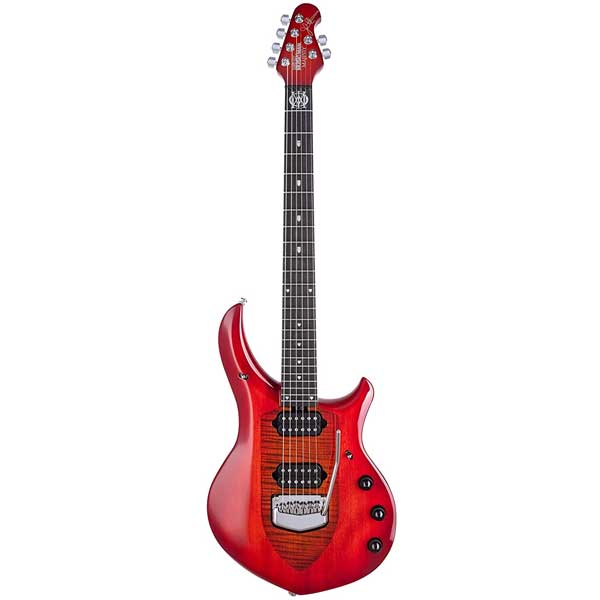
| Estimated Price | $3500 |
| Body Style | Double Cutaway |
| Top | Mahogany |
| Back and Sides | Mahogany |
| Neck | Mahogany |
| Finish | Matte |
| Body Bracing | – |
| Fret Count | 24 |
| Country of Origin | USA |
My Review: Music Man was founded in 1974, and they were first known as a company that introduced active electronics on their production lines. The famous music accessories entrepreneur Ernie Ball’s son Sterling Ball – who is a legendary instrument designer and a musician by his own right – was on the team since the 1970s. He helped develop the famous StringRay Basses, and Ernie Ball company officially bought Music Man in 1984. In 2001, they teamed up with John Petrucci, one of the all-time great metal guitarists, and launched John’s first signature model: The JP6. Ever since then, John Petrucci and the team at Music Man never stopped innovating and developing and created a total of 9 signature John Petrucci signature guitars. The amazing thing about his signature lines is that John personally always uses his signature guitars in his Dream Theater tours, recordings, and songwriting process. This is quite rare in the guitar world because many guitarists with their signature line will use multiple different guitars when they are actually playing on stage. But John exclusively uses his signature models, and over time, he was able to gather all kinds of feedback, make adjustments, and do experiments to create the best possible instrument. With over 18 years of experimenting and developing multiple signature models, the one and only Majesty were born. It’s THE pinnacle of all his creations and his Majesty is simply put, one of the best signature guitars you’ll find anywhere.
The design of the Majesty is said to be inspired by sports cars and running stallions, and it’s pretty obvious when you look at these. As the name suggests, it’s really a majestic looking instrument, and it also comes in multiple beautiful colors – Blue Hanu, Dark Roast, Enchanted Forest, Red Sunrise, Solar Dust, Stealth Black, and Tiger Eye. And the really cool thing about it is that different color models have slightly different features to them. For colors like Enchanted Forest, it has a mahogany neck and maple top and has matte black hardware. For two colors, like the Kinetic Blue, the color changes depending on where the light hits the surface. So for those models, the body is composed of basswood and has chrome hardware. The Tiger Eye color is a separate limited edition model with a completely different body composition. So even amongst the same model, there are slightly different aspects to it, and these aspects will all result in slightly different tones. The pickups are designed by John Petrucci – his new Rainmaker and Dreamcatcher humbuckers. These are very powerful machines by themselves, and these are the culmination of John’s work over many years and his constant development for the best pickup that would suit his guitar. He says these humbuckers bring out the Majesty’s inherent tonal complexities “in a way that gives the guitar an expressive, intense, fearless, creamy, gorgeous, pure, unobstructed, and addictively powerful voice.” Although the Rainmaker and Dreamcatcher humbuckers can work well with any amps, John Petrucci’s preference for amp pairing is a Mesa Boogie or other high gain 6L6 amps.
All Majesty guitars have 24 frets, and the neck is long and it’s not blocked by the body, so you can access all 24 frets on both sides of the guitar. It really incorporates all the best sounds from all JP’s previous signature models and John Petrucci describes this guitar as a “really bold, present, up-front, sustaining personality”. The volume knob has a switch, and you can access the 20db boost feature. The tone knob has a coil tap button feature. On top of that, there is something called the Piezo function. And what this does is when the switch is set to Piezo, you can access super high-quality acoustic steel-string guitar sound. Naturally, it’s not a perfect acoustic guitar sound, but it has a seductive quality on its own. In terms of live performance, it can work beautifully, and unlike an actual acoustic guitar, you can mix and match any effects on it without worrying about possible feedback problems from the amp. It’s a really futuristic feature and you can even combine the Piezo pickup + the regular magnetic pickup. They all have a mahogany neck-through design, mahogany sides, and either a maple top or basswood top. It also comes in 7 strings. I mean with all these crazy futuristic features and amazing tones, this model is way ahead of its time and revolutionizing the electric guitar. There are definitely guitar players who prefer the old, the vintage, the classic such as a Gibson, a D’angelico, or a Fender. But if you’re someone who wants a futuristic, modern guitar, and if you have the budget, I don’t know if you can find anything better in that department than an Ernie Ball Music Man John Petrucci Majesty. This guitar would obviously work for all genres, but I think it would suit the modern rock genres better – like Prog Rock and Metal.
11. Taylor Baby Mahogany BT2e
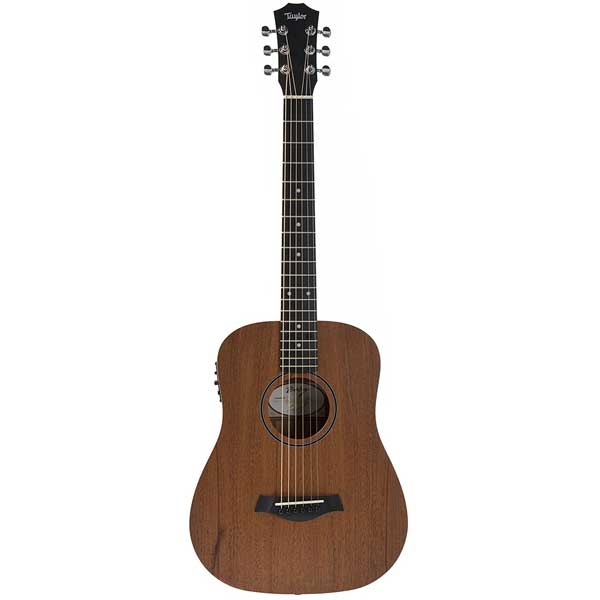
| Estimated Price | $470 |
| Body Style | Dreadnaught ¾ size |
| Top | Solid Mahogany |
| Back and Sides | Layered Sapele |
| Neck | Sapele |
| Finish | Matte 2.0 |
| Body Bracing | X-bracing |
| Fret Count | 19 |
| Country of Origin | Mexico |
My Review: Speaking of small acoustic guitars with pickups, let’s take a look at another mini guitar by Taylor – Taylor Baby Mahogany BT2e. This one has a clear characteristic that stands out from other mini guitars, and it has a very dark tone. This is a big deal because most Taylor guitars are known for their signature bright sound, and the BT2e has a darker and warmer sound than its Martin counterpart.
Like the other mini guitars, BT2e has ¾ size body with 22 ¾ inches in total. It only has 19 frets, and the guitar body is made up of mahogany with laminated top, back, and sides. The guitar has a no cutaway ¾ Dreadnought body, so it’s a great opportunity for beginners to get used to the dreadnaught body shape before purchasing a regular sized dreadnaught body guitars. The construction lives up to the Taylor brand name, and BT2e has the X-bracing for the maximum resonance of the guitar. The electronics on the guitar are Taylor’s own ES-B preamp and pickup system. Just like the Yamaha APXT2, it’s a rather simple system with just one tone knob, volume, and a tuner.
The tone from this guitar is extremely soft and mellow – perfect for playing chords and rhythm. Some describe this tone as almost like a nylon guitar because of its mellow sound. You can add a little bit of brightness by picking harder and strumming harder, but the general tone profile of the BT2e is warm. Now you might ask why would I spend $469 for a ¾ size guitar with electronics when I can buy a guitar like the Yamaha APXT2 in less than half of the price? The benefits of this guitar would be the Taylor brand name, and the build quality would be much higher than the Yamaha’s ¾ sized guitar. The wood is also much higher quality – all mahogany. There are little details like Tusq nut/Micarta saddle and Pearloid Dot inlay that makes this guitar a higher quality instrument than the Yamaha.
Because of its warm and mellow tone, I personally find it much easier to work with a warm-sounding acoustic guitar when you’re plugging it into an amp or a PA system. The small body makes it suitable for beginners and kids, but the quality makes it a great option for more experienced guitarists looking for a small body guitar. All in all, all the different ¾ acoustic guitars have their own unique advantages, and if you’re looking for a mini dreadnaught with electronics and a warm tone, Taylor BT2e is among your best choices.
Related Popular Article: Our Favorite Guitar Straps
12. Yamaha FS800 Concert
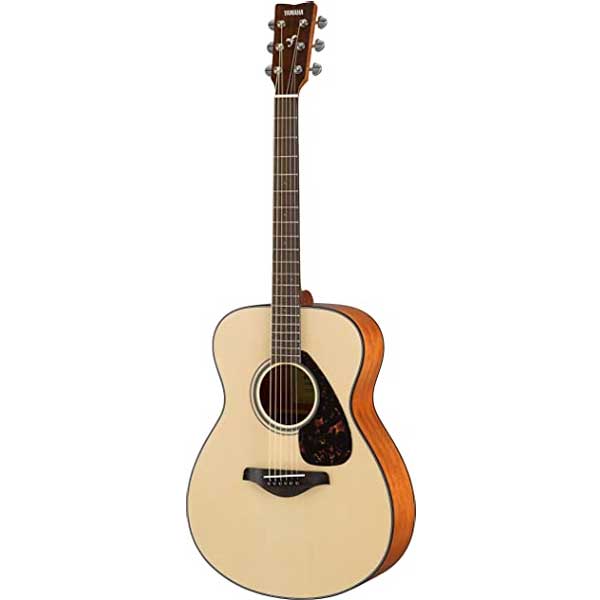
| Estimated Price | $200 |
| Body Style | Concert/O |
| Top | Solid Spruce |
| Back and Sides | Nato/Okume |
| Neck | Nato |
| Finish | Gloss |
| Body Bracing | Scalloped |
| Fret Count | 20 |
| Country of Origin | China |
My Review: Here is a guitar that has one of the best reviews of any beginner acoustic guitars. It has even better reviews than the previously looked at Yamaha FS800. The amazing thing about this particular instrument is that even though it’s only $200, the construction quality is really top-notch.
First of all, the guitar is very well balanced from the head and the body. This means when you put it in your lap, it’s going to feel natural and comfortable. Secondly, the guitar has a solid Sitka Spruce top instead of a laminated top. Solid tops sound much louder and resonate better than laminated tops, and Yamaha somehow managed to make this possible all within $200.
The back, sides, and the neck is made up of Nato, and they are laminated, and the fretboard and the bridge are composed of rosewood. Thirdly, the guitar is actually the full size – 25’’ scale length, but the feel of the guitar is comfortable even for beginner guitar players with small hands. This is due to a smaller guitar body in the rounder design and has a thinner body than other standard guitars. The neck of the guitar is also relatively thin and comfortable so that even beginners can easily wrap their hands around the guitar neck. If you’re someone with small hands that wants to practice on a full size guitar, this guitar would be a great starting point to building up to bulkier guitars. Lastly, Yamaha managed to build the guitar with scallop X bracing, and it’s really mindblowing that even with all these features, the guitar is sold at $200.I talked about X bracing with the other guitars, and they will improve the resonance and gives richer harmonic overtones.
The sound of this guitar is on the warmer side with solid bass and a good amount of sustain. But the treble of the guitar is also clearly existent, and it’s perfect both Fingerstyle playing and strumming with a pick. Obviously, Yamaha FS800 wouldn’t sound like a $3000 Martin guitar, but comparing it to other beginner guitars at this price point, the sound is top-notch. Whether you want a full size guitar that feels super comfortable for super hands, or if you’re looking for a cheap guitar that has great tone and playability, the Yamaha FS800 is definitely among your top choices.
13. Martin OOOJr-10 Acoustic Guitar
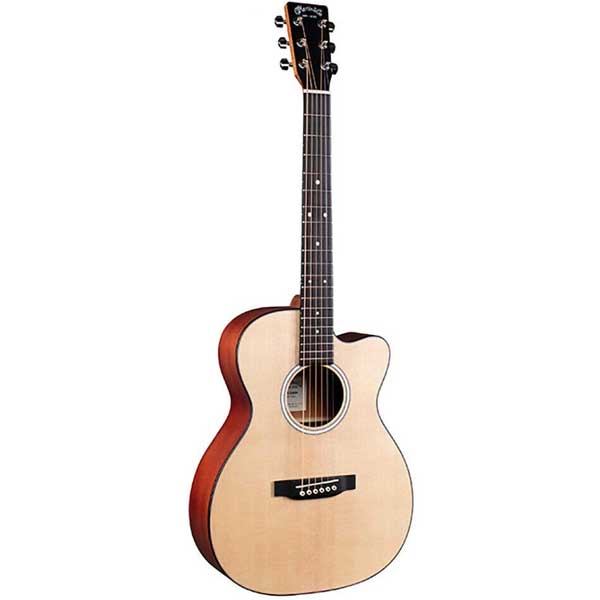
| Estimated Price | $500 |
| Body Style | Dreadnought Junior |
| Top | Sitka Spruce |
| Back and Sides | Sapele |
| Neck | Solid hardwood |
| Finish | Satin hand rubbed |
| Body Bracing | X Bracing |
| Fret Count | 20 |
| Country of Origin | Mexico |
My Review: Martin OOOJr-10 is a guitar that is between the high-end guitars and the beginner guitars, and it offers the legendary Martin’s guitar quality while being $500. Most USA-made Martin guitars cost well over $2000, and it’s a price that most people can’t imagine spending on a single guitar… But the good news is that there are cheaper versions like the Martin OOOJr-10 available.
This guitar can be characterized as a guitar with a huge sound in a small body and the body shape is dreadnought junior. It has a very unique size – 24’’ scale length, which is about an inch shorter than average full-sized guitars, and slightly longer than ¾ size guitars. It’s a good size for people with smaller hands that want to get a guitar that can produce bigger sounds than ¾ size guitars. The mini auditorium body style provides a really comfortable fit for guitar students, kids, and smaller adults. Even if you want to transition from this junior size to regular size, there wouldn’t be much of a learning curve.
The top is made of Sitka Spruce, and the back and the sides are made with Sapele. It also features a hand-rubbed neck with a high performance taper. Because of this, moving around the neck is effortless and comes easy even for beginners. The guitar body has scalloped x bracing construction, and they added a soft back edge on the body for maximum comfort. Comfort is so crucial for people who are just starting to play guitar, and I’ve seen too many people quickly lose interest because they have difficulty making sound on the guitar. This guitar provides maximum comfort while projecting a large sound.
The tone is quite warm and has a strong midrange, and is very responsive to picking or plucking with fingers. Because they are so easy to grip compared to other chunky guitars, you can easily get more tone and expression out of the notes when you play this guitar. Also perfect as a traveling guitar using the soft case that it comes with, and you can fit it into an airplane as a carry-on bag and take it anywhere with you. If you dreamed of getting a Martin but can’t afford the $3000 models, you can satisfy your dream by getting the Martin OOOJr-10 guitar.
14. Squier Classic Vibe ‘70s Jaguar
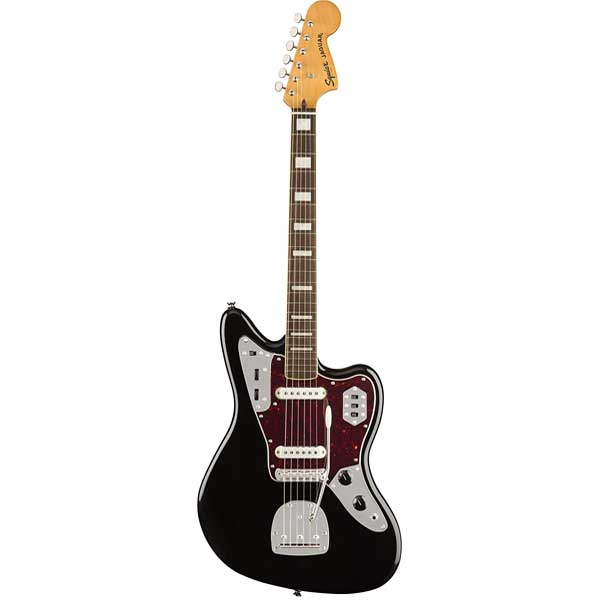
| Estimated Price | $450 |
| Body Style | Offset |
| Top | Poplar |
| Back and Sides | Poplar |
| Neck | Maple |
| Finish | Gloss |
| Body Bracing | – |
| Fret Count | 22 |
| Country of Origin | Indonesia |
My Review: Now that we’ve looked at an affordable version of a Gibson guitar, let’s take a look at an affordable version of Fender – Squier guitars. Just like Epiphone, Squier was an independent company making string instruments since 1890 and Fender bought the company in 1965. Since then, Squier has been making cheaper versions of Fender guitar models. Among the many Fender guitar models, Jaguar has a scale length that’s slightly shorter than full size guitars. It has a very unique design, and you’ve probably seen this guitar in action by guitarists non-other than Kurt Cobain or even John Frusciante of Red Hot Chili Peppers.
The Squier Classic Vibe ‘70s Jaguar is the updated version of the previous Squier Vintage Modified Jaguar. First off, this particular guitar has a scale length of 24’’, which is more than a full inch shorter than other Fender guitars. It’ll be a perfect guitar for younger players to start with, and the C profile maple neck also provides a comfortable grip for guitar players with small hands. One of the most updated features is the bone nut instead of a plastic nut. Even though this might not sound like a big improvement, the bone nut will have much better sustain and resonance of the strings than the plastic nut.
Another noticeable change is the pickups. Squier now uses Fender Alnico single coil pickups that are specifically designed for Jaguar. Alnico magnet pickups are much higher quality than the previously introduced ceramic pickups and you will be able to get a much more clear and detailed clean tone with the Alnico magnet pickups. These guitars are quite versatile, and you can use them for jazz, pop, rock, funk, and even blues.
This model also upgraded its saddle to Mustang style barrel saddle and features a three way pickup selector – neck only, neck & bridge, and bridge only. And something unique to Jaguar is that you can control Lead Circuit Controls and Rhythm Circuit Controls separately, and this will be a huge asset to those guitar players that want to explore many different genres. At only $450, Squier Classic Vibe ‘70s Jaguar offers a unique one-of-a-kind design combined with great craftsmanship and versatility.
15. Squier Mini Strat Electric Guitar
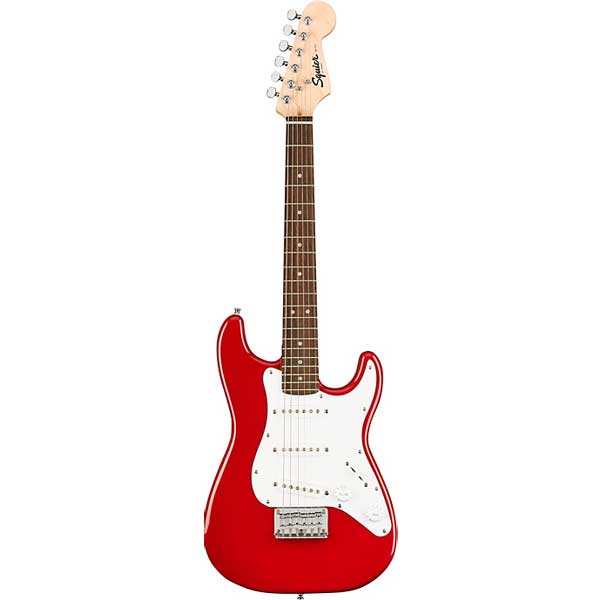
| Estimated Price | $180 |
| Body Style | Double Cutaway |
| Top | Laminated Hardwood |
| Back and Sides | Laminated Hardwood |
| Neck | Maple |
| Finish | Gloss Polyurethane |
| Body Bracing | – |
| Fret Count | 21 |
| Country of Origin | Indonesia |
My Review: Strats… They are THE most famous electric guitar models, and we have to talk about a Strat model when we’re discussing electric guitars. But for guitar players with smaller hands, the regular sized Stratocaster will have a scale length that is well over 25’’. So instead of recommending a full size Stratocaster, here is a ¾ version made by Squier – The Squier Mini Strat.
Coming in at only 22.75’’ scale length, the guitar is perfect for small hands and can also be used as a convenient travel guitar. Other than the size and woods for the guitar, it shares many similarities with a genuine Fender Standard Stratocaster. The Squier Mini Strat has the usual 3 single coil pickups – neck, middle, bridge with 5-way blade pickup switch, so you can have access to all 3 and 2 more combinations of the different pickup sounds. Other than that, the Squier Mini also has a large ‘60s headstock and has a synthetic bone nut. It uses Poplar wood for the body and has a slim maple neck with a C profile. The neck is very accomodating for small hands.
Even though it’s cheaper than $200, the Squier Mini Strat has a decent enough tone for playing various kinds of music – blues, rock, pop, jazz, etc… It’ll be perfect for learning the
guitar for the first time, and if you’re a beginner that loves the Strat shape, I highly recommend getting yourself a Squier Mini Strat!
16. Epiphone Les Paul Standard ‘60s
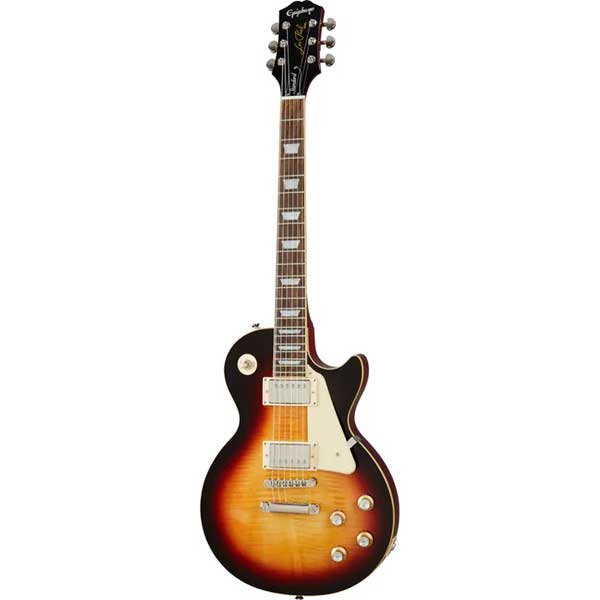
| Estimated Price | $600 |
| Body Style | Single Cutaway |
| Top | AA Flame Maple Cap |
| Back and Sides | Mahogany |
| Neck | Mahogany |
| Finish | Gloss |
| Body Bracing | – |
| Fret Count | 22 |
| Country of Origin | China |
My Review: You might be wondering about a Les Paul that can work with your small hands… Les Pauls are just as iconic as Strats or Teles and they are such a big part of modern electric guitars. From Jimmy Page to Slash to Duane Allman to Joe Bonamassa, we’ve got to talk about Les Pauls when we’re discussing electric guitars. The shape of Les Paul never gets old, unaging classy beauty. That being said, I was a little reluctant about including a Les Paul because the full sized Les Paul might be a little hard to play for someone with small hands, but the Les Pauls still have a smaller body and shorter scale length than Fender Strats or Teles. Les Pauls historically have a scale length of 24.75’’, which is slightly shorter than many other full size electric guitars. Still, it’s definitely long compared to other guitars on this list, so keep that in mind if you’re interested in a Les Paul.
Epiphone Les Paul Standard ‘60s are made to encapsulate genuine 1960s, Gibson Les Paul, at a very affordable price point. And Epiphone has got it done over and over, and you can rest assured that you are getting the best bang for the buck. You’ll find that most features of this guitar are almost the same or very similar to a real Gibson Les Paul, but for a quarter of the price. First of all, Epiphone Les Paul has a mahogany body with a mahogany neck – and the essential identity of being a Gibson guitar. The top is also finished with a gorgeous AAA flame maple top.
Secondly, this guitar has close-to-authentic Grover Rotomatic machine heads for the tuning machines and even has a LockTone ABR Tune-o-matic bridge. It’s also wired with high quality CTS electronics, just like you would find on a 1960s Gibson Les Paul. One of the best things about this model is its pickups – the revolutionary Epiphone Alnico ProBucker pickups. These pickups have won many awards for their amazing quality, and even though they are not the ones used in Gibson Les Pauls, they can get a pretty close sound to the original. ProBucker pickups have Alnico II magnets, and ProBucker 2 is used for the neck pickup and ProBucker 3 for the bridge.
The tone from the guitar is rich and warm and full-sounding. The highs are also very present, combined with a tight low end. You can get the band Cream’s signature Clapton sound or even Led Zeppelin sound with this guitar. It’s fat and sustains for a long time. The relatively small body of Les Paul will allow you to easily fit this instrument onto your body, and soon you’ll be jamming away with that classic overdriven blues/rock guitar sound. Epiphone Les Paul Standard ‘60s is a top-notch instrument available at an affordable price.
17. Jackson Dinky Arch Top JS32 DKAM
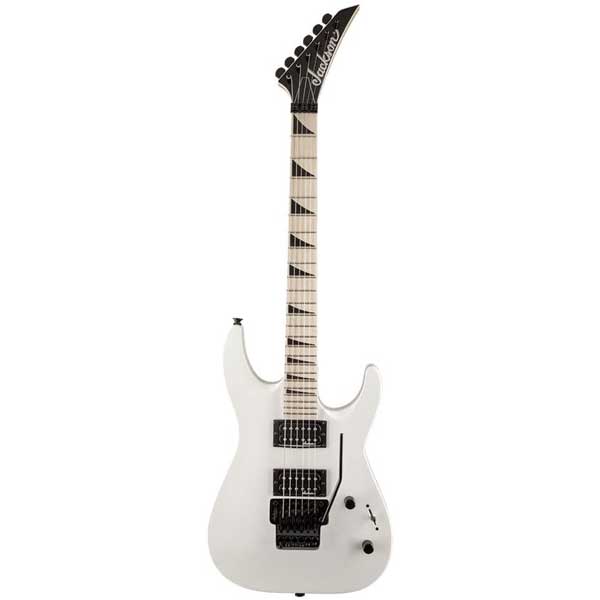
| Estimated Price | $230 |
| Body Style | Dinky |
| Top | Poplar |
| Back and Sides | Poplar |
| Neck | Maple |
| Finish | Gloss |
| Body Bracing | – |
| Fret Count | 24 |
| Country of Origin | China |
My Review: Just in case some of you are into metal, we’ve included a Jackson guitar. Jackson guitars are the go-to brand for metal guitars, and they are built for maximum speed and comfort. The pickups on Jackson guitars will usually have very high output, and you can easily get a very powerful sound out of their guitars. For this review, I chose the Jackson Dinky Arch Top JS32 DKAM.
The Jackson Dinky JS32 is a cheap guitar with high quality functions and parts. It has a lightweight poplar body and arched top and has a maple neck. Even though the scale length is 25.5’’, the super thin neck allows you to grip the neck easily even with small hands. The neck is called a “speed” neck, and the super thin neck allows you to bend notes easier, move up and down the neck faster, and grab chords and notes with ease.
Jackson Dinky JS32 also has a compound radius fretboard, and this adds to the comfort when you’re moving up and down the strings. For just $300, the guitar also has a high quality Floyd Rose double locking tremolo bridge. This allows you to change the pitches of the notes and do wild vibratos, all without losing the tuning. The pickups are Jackson’s high output humbuckers, and these are ceramic humbuckers that are perfect for a lot of distortion.
The sound of Jackson JS32 is powerful and has a lot of sustain. Because of its high output nature, I wouldn’t recommend this guitar for playing clean tones for genres like pop and jazz. But for hard rock and metal, this guitar is a great choice for fast arpeggios, fast runs, tapping, wild bends, hardcore palm muting, power chords – all the things you need for metal.
Choosing the Right Guitar for Small Hands (Buying Guide)
This section is for those of you who want to learn more about what to look for if you have small hands.
Guitar Scale Length
The scale length of a guitar determines the length between the nut and the bridge of the guitar. Different models have their own specific scale length – Many Gibson and Epiphone models have 24.75’’ scale length, Fender and Ibanez use 25.5’’, and a classic Martin HD-35 acoustic guitar has a scale length of 25.4’’. If we look at a guitar that was designed for small hands and a smaller body like the Little Martin, the scale length is 23’’, a lot shorter than regular sized guitars.
The scale length will affect the spacing of the frets, and guitars with longer scale lengths will have larger fret spacing. With larger spacing, obviously, you would have to stretch your fingers more, and so guitar players with smaller hands would have an easier time playing guitars with shorter scale lengths.
Another thing that scale length affects is the tension of the strings. The guitars with longer scale length will naturally have higher tension in the strings, and so you would have to apply more force from your fingers to play a note. But one thing to keep in mind is that longer scale length allows the strings to resonate and sustain more, so tiny guitars will naturally have less sustain than regular sized guitars.
Guitar Neck Profile
When you’re looking for the guitar that would fit your small hands, another crucial piece of the puzzle is the guitar neck profile. The guitar neck profile determines the shape and the thickness of the guitar neck, and it directly affects how you grab your guitar and press onto the fretboard.
The most common types of neck profiles are C shape, V shape, D shape, and U shape. C shapes are the most common, and they are widely regarded as the most comfortable for the general public. Many vintage instruments like the Vintage Fender Strats and Teles will have thicker neck shapes like the V shape or U shape, and this might be suitable for the players with bigger hands. Many modern shredding rock guitars by companies like Ibanez or Music Man have a super-thin neck, allowing players to shred and move around the neck freely. If your hands are too small to wrap around a classic “C” neck shape, then looking for a guitar with a thinner neck profile than average might be the way. Body Size
Body size is also a big factor in choosing the right size instrument for people with small hands. A full-sized acoustic guitar and hollow body electric guitars will have a much larger body than solid body electric guitars, and children and even shorter adults might have trouble wrapping their arms and body around the guitar. If the guitar body is too big for your body, you could have some serious problems looking at the fretboard or even reaching the frets.
In many cases, regular-sized guitars with contoured body shapes can fit comfortably to a person with a smaller body shape. So when you’re purchasing a guitar, the best thing to do is try them out in person, because certain guitar body shapes might fit you perfectly even if you have small hands.
36 Inch Guitars Explained
Guitars are also called 36-inch guitars, and they are a smaller version of the regular full-sized guitars. The typical size of a guitar is 38-inches, but ¾ guitar is just 2 inches shorter. They are the perfect first guitars for young adults and adults with small hands.
There are even smaller versions of the regular guitars, and these are geared towards children under the age of 8. ½ sized guitars are 34 inches in length, while the ¼ sized guitars around 30 inches in total. Although ½ size guitars are a popular choice as a learning tool for small children, ¼ sized guitars are not recommended, because you might be better off buying the toddlers toy guitars instead of ¼ sized guitars.
Today, we have selected 17 acoustic and electric guitars that are perfect for your small hands. The list from number 1-8 will be featuring acoustic guitars at a whole wide range of prices, and number 9 to 17 will be featuring electric guitars. Let’s take a look!
Wrap Up:
That does it for this review, let us know what you think is the best guitar for small hands in the comments below. Also, let us know if there is a guitar we left off this list that you feel is worthy of being added. As always feel free to drop any questions you have below.

My name is Chris and I’ve had a passion for music and guitars for as long as I can remember. I started this website with some of my friends who are musicians, music teachers, gear heads, and music enthusiasts so we could provide high-quality guitar and music-related content.
I’ve been playing guitar since I was 13 years old and am an avid collector. Amps, pedals, guitars, bass, drums, microphones, studio, and recording gear, I love it all.
I was born and raised in Western Pennsylvania. My background is in Electrical Engineering, earning a Bachelor’s degree from Youngstown State University. With my engineering experience, I’ve developed as a designer of guitar amplifiers and effects. A true passion of mine, I’ve designed, built, and repaired a wide range of guitar amps and electronics. Here at the Guitar Lobby, our aim is to share our passion for Music and gear with the rest of the music community.
